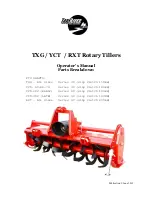
PRGD-SVX01F-EN
11
Purge Tank Subsystem
Any non-condensables that have accumulated from the
refrigerant vapor are left behind to collect in the purge
tank. As the quantity of non-condensables increases,
the heat transfer efficiency of the purge evaporator coil
is reduced, causing the purge compressor suction
temperature to decrease.
A float switch, mounted in the bottom of the purge
tank, indicates if there is excessive accumulation of
liquid refrigerant in the tank. A liquid level sensor,
which resides in the purge control panel, monitors the
status of the float switch.
If the normally closed float switch is open for more
than 20 minutes, the purge controls will turn off the
refrigeration system and generate a non-latching
diagnostic—Purge Liquid Level Too High Warning. If
the float switch has re-closed after 20 minutes, the
purge controls will restart the refrigeration system.
If the float switch remains open for more than
20 minutes, or if the float switch/liquid level restart
cycle has occurred more than four times in four hours,
a latching diagnostic—Purge Liquid Level Too High
Continuously—will be generated. The purge system
will not restart until it is reset.
If a Purge Liquid Level Too High Continuously
diagnostic occurs, check the purge lines for any type of
restriction (trapped liquid, closed valves, etc.) and
ensure that the filter-drier on the liquid return line is in
good condition.
A UL-required pressure-relief device (fusible plug),
which protects against over-pressurization of the purge
tank, is mounted on the purge tank. The plug material
will fuse at 210°F (98.9°C), which equates to
approximately 98 psig (675.7 kPaG) for refrigerant R-
123.
Pump-out Subsystem
When the purge control subsystem detects the
presence of non-condensables in the purge tank, the
pump-out solenoid and exhaust solenoid valves open,
and the pump-out compressor turns on. The valves and
the compressor cycle on and off as needed to achieve
an efficient and fast removal of non-condensables.
N
No
otte
e:: A High Vacuum Pump option is available for
applications that require purge operation at low
condensing temperatures and pressures. This
option provides a two-stage pump-out
compressor. The High Vacuum Pump option
allows the purge system to operate to saturation
temperatures as low as 34°F (1.1°C). Typical
applications that may require the High Vacuum
Pump option include free-cooling installations,
series chiller installations, ice systems having
brine flowing through idle chillers, chillers
installed outdoors or in unconditioned spaces, or
any application that may cause very low
condenser water temperatures.
Carbon Tank and Regeneration
Subsystem
The discharge from the pump-out compressor is piped
through the carbon tank. The special carbon in the tank
effectively scrubs and collects refrigerant molecules
from the non-condensable gas before the gas passes
through the exhaust solenoid valve to the chiller vent
line.
A 175 W resistive heater is mounted inside the carbon
tank and is used to periodically “regenerate” the
carbon bed and drive any collected refrigerant vapor
back into the chiller. A UL-required pressure-relief
valve, rated at 150 psig (1034.2 kPaG), is mounted on
the line leaving the carbon tank. The valve protects
against over-pressurization of the carbon tank.
A temperature sensor is installed through the top of the
carbon tank shell so that the controls can monitor the
carbon bed temperature. The temperature sensor
controls the regeneration cycle and protect against
overheating. If the limit temperature is reached, the
system shuts down and a Purge Carbon Regen
Temperature Limit Exceeded diagnostic is generated.
Tracer AdaptiView Control Subsystem
Tracer UC800 controller
Control of the EarthWise™ purge system is provided
by the Tracer® UC800 controller. The controller is
mounted in the chiller control panel and is used to
interface with the purge system as well as the chiller.
Tracer AdaptiView display
The operator interface for control of the chiller,
including the purge system, is the Tracer®
AdaptiView™ display. For detailed information on the
display, refer to
Operations Guide: Tracer AdaptiView
Display for Water-Cooled CenTraVac Chillers
(CTV-
SVU01*-EN).
Much of the purge setup, operation, and
troubleshooting can be accomplished using the
Tracer® AdaptiView™ display. However, more
advanced functions require the use of the laptop-based
Tracer® TU service tool. For more information, refer to
Getting Started Guide: Tracer TU Service Tool
(TTU-
SVN01*-EN).
Sensors
The following sensors are used to enable control
communication between the Tracer® UC800 controller
and the EarthWise™ purge system. The sensors use
low-level intelligence devices (LLIDs) to communicate
with the Tracer® UC800 controller.
•
C
Co
om
mp
prre
esssso
orr ssu
uccttiio
on
n tte
em
mp
pe
erra
attu
urre
e sse
en
nsso
orr.. This
sensor is mounted on the purge condensing unit
suction line. The controller uses the value of this
temperature sensor to decide whether or not to
purge non-condensables from the purge tank.
When the temperature drops to a specified point,
P
Pu
urrg
ge
e S
Sy
ysstte
em
m O
Ov
ve
errv
viie
ew
w
Summary of Contents for PRGD series
Page 35: ...PRGD SVX01F EN 35 S Sc ch he em ma at ti ic c W Wi ir ri in ng g D Di ia ag gr ra am m ...
Page 36: ...36 PRGD SVX01F EN S Sc ch he em ma at ti ic c W Wi ir ri in ng g D Di ia ag gr ra am m ...
Page 37: ...PRGD SVX01F EN 37 N No ot te es s ...
Page 38: ...38 PRGD SVX01F EN N No ot te es s ...












































